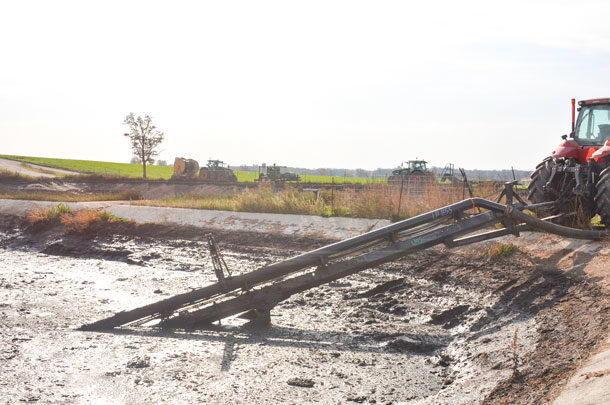

Safe and secure manure storage is very important on your dairy. In order to maximize contents during the growing season, manure pits must be agitated and pumped out regularly. Although on some operations this task only happens a few times a year, planning ahead, developing safe operating procedures and ensuring everyone is trained on manure pit safety will help keep employees and anyone else that may be on the farm safe. Let’s take a moment to examine some of the common hazards.

The best practice is to never enter a manure pit. Every time you enter a manure pit, you should treat it as a potentially lethal space. Just because you may have entered a pit in the past without incident doesn’t mean you can do so again now. There’s no way to know how conditions might have changed or what gases have built up since the last time. As such, you need to be prepared for anything.
Avoid the need to enter a manure pit, but if you must, be sure to use the appropriate testing equipment to test the environment prior to entry and wear the appropriate personal protective equipment (PPE), which may include a supplied air respirator or self-contained breathing apparatus. You must also have two monitors (people) posted in a safe location nearby with their own PPE and adequate rescue equipment to ensure that a quick and safe evacuation can be performed if needed.
Stored manure consumes oxygen and releases hazardous gases, including hydrogen sulphide, carbon dioxide, methane and ammonia. The combination of low oxygen and accumulated gases above the manure can swiftly overcome workers and farmers without warning. Atmospheric conditions in and around pits and other manure containment may be safe on some days and deadly on others. Don’t rely on past luck with uneventful entries. Your sense of smell will not keep you safe from manure gases. Risk for harm is generally higher in enclosed or confined structures like tanks or pits.
High levels of manure gas are released during activities that disturb the manure, such as pumping and agitating it. These gases can enter attached barns or adjacent buildings, so adequate ventilation is very important. Even sludge and residue at the bottom of drained pits, tanks and other containers can emit dangerous amounts of manure gases. Gas production will increase at warmer temperatures. Some manure gases, like methane, are potentially ignitable and explosive.
Keep in mind that toxic gas and low oxygen levels can be present near manure pumps, in confined spaces and in other equipment areas as well. Ensure proper monitoring is used before entering any confined space, including underground pump areas.
Ask yourself, have we implemented the following: Make manure pit, pond, basin and lagoon boundaries visible. Put up a safety fence or block off boundaries to prevent unsafe access. Lock gates and access to ensure safety. Add appropriate safety covers for tanks and access openings to manure pits and other confined spaces to keep people out. Post and maintain appropriate warning signs around manure storage. Use reflective tape or bright paint for better visibility in low light.
Prevent rescuers from becoming additional victims. Make plans on what to do should emergency rescue become necessary. Any individual involved in rescue or retrieval must have special training and equipment and follow all applicable safety procedures. Ensure that everyone on the dairy has been trained on this procedure by reviewing and discussing the safe operating procedure as well as conducting annual refresher training. Document this training.
AdvertisementA key prevention solution is to ensure effective ventilation is in place. Mechanical ventilation may be necessary to replenish oxygen and remove hazardous manure gases, especially when manure is being agitated or pumped. Keep in mind that ventilation may not always be enough. If workers must enter pits, tanks, other manure storage areas or other areas where gas may accumulate, you should purchase or rent the appropriate air/gas monitoring equipment. Follow established procedures on how to safely and effectively conduct gas monitoring before any entry.
If you must enter manure storage, you’ll need to wear the following PPE: self-contained breathing apparatus, safety harness with lifeline, eye protection and face shields, and coveralls and gloves.
At least two other personnel should be on hand to assist in a rescue, if necessary. At no point should a rescuer enter a pit without proper breathing equipment, otherwise he or she runs the risk of becoming a victim too. Prior to a worker entering the pit, discuss as a team what emergency steps you will take should the worker get in trouble while in the pit. Document the steps and have each worker sign off on this document.
Post signage at applicable manure pits as a visual reminder for all workers and visitors to the dairy.
By following these steps and by having everyone take part in ensuring a workplace safe from manure-pit hazards, we can help keep our entire team safe.